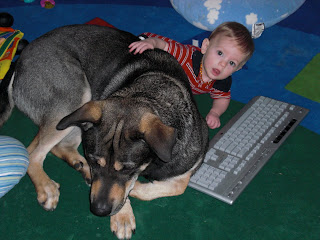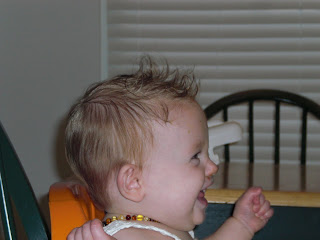Exploring different colors, textures, and patterns
Empty Vessel - A child is an empty vessel that brings nothing to a new experience. When you tell them or show them something new it will start to fill the vessel and they have "learned" it. A child can only learn so much before their vessel is full and things either don't go in or other things fall out. This is the most extreme of the nurture arguments. There is no Science to back this up and anyone who has spent any amount of time with a child laughs at the thought that a child brings nothing to a new experience or that they completely learn something after seeing it only once. I should note that this is the basic theory that the current US educational system is based on - this combined with the factory model, to be more accurate.
Yummy toys
IQ - The debate here is if IQ is something you are born with or if it can change with experiences. Can you learn to increase your IQ? The simple answer is yes. IQ changes throughout life (more than could just be accounted for by testing errors) and you can learn techniques to improve your IQ. Once you know that you can improve your mental capabilities there is an automatic measurable cognitive improvement over people who think it is set - before you even do anything else. The number one thing you can do to increase cognitive processing (as judged by fMRI) is aerobic exercise. Number two is nutrition and third is education. Education in this case needs to be something new, interesting, and challenging. Doing soduko puzzles is great, but will only help for about a year, after that you need to find something else. Learning to dance, rebuild an engine, or learning a new language will all benefit you if they are new, interesting and challenging. Children are much better at this than adults, as most adults tend to stick with the same hobbies/job for years on end.
Playing with buttons and our sweet little dog
Ladder theory - Your mind is like a ladder. You must learn everything for the first rung before climbing onto the second. You must learn how to stand before you learn how to walk. You will learn to walk before learning to run. This theory is how most people think we learn. Each subject is a different ladder and you climb up even, steady steps to work your way to the top. If you manage to only weakly develop a step or try stepping over, it will catch up to you and you will fall until you learn the material. Most people, when pressed, can come up with an example in their life of how this doesn't hold true. The musician who can perform a concerto, but doesn't know all of their scales would just be one example. This is a good basic theory, but it just doesn't hold true.
Playing with the doll house
Spider web theory - Each item you learn is a point on a spider web. The more connections that item has to other things you know the stronger the web. Things learned with no context or connections will quickly fall off and be forgotten. For example, a child learning about the fraction 1/4 could connect that to a quarter note in music, a quarter of a dollar, a quarter of a football game, 25%, .25, quarter of an hour, quarter pound burger, etc. You can see how this would make it a much stronger connection. There has also been research done showing that if you change the way and location of teaching an item the more likely it is to be remembered. For example, students taught the same math problems in class were divided into two groups for homework. One group did nothing out of the ordinary. The other group was told to do all of their math homework while sitting in the empty bathtub. The bathtub group did remarkably better. So if you are trying to teach a child something that doesn't have a lot of other connections, change up the where and how you are trying to teach it.
Playing in the doll house
Roads theory - You find yourself in the middle of the country - no roads or development of any type to be seen. First, you must find water. After walking awhile you find a stream of fresh water and you notice your foot prints on the path that took you there. Next you look for shelter and a little way off you discover a tree that offers shade and some fruit to eat. Over the next few days you keep exploring and you notice the path between the stream and the tree no longer has anything growing on it. It's a simple dirt path, while other paths are still foot prints. As you continue to explore and discover some paths fade away because you stop walking on them, while other paths grow and become more defined. Skip forward in the story - You now have dirt paths, country roads, streets, and even a few highways. The highways allow you to go faster, but sometimes the exits are just close to where you are headed rather than taking you right there. They do allow you to go over some streets without even acknowledging them.
Apply this theory to your mind. Those paths that you develop start to work faster. When you first learn to walk you have to think about being balanced, picking up one leg, moving it forward, setting it down, still staying balanced and doing it all over with the other leg. After spending a lot of time practicing this skill you can walk without any thought at all. When you were in first grade you knew all of your classmates names, yet 20 years later you likely don't remember very many. A road not traveled, grows over and is forgotten. If someone asks you what the Pythagorean theorem is, you are likely taken back to when/where you learned it. You quickly (highway) got there and know when/where you learned it or last used it (exit), but it probably takes a few minutes or longer to remember specifically what it is (lesser used roads). If you use this theorem daily, choose another example.
Playing with trucks
Each of these theories tells us something about our minds. The last two are the ones most supported by current Science. As you are teaching your kids, think about the differences in the theories and how you can apply them to your time. The more important something is the more times you want them to walk that path and the more connections to other things you want to make. When all else fails, sit in an empty bathtub!
Happy with wet curly hair








I loved finding your blog! I also run a blog where I do research based posts on Friday. I've been trying to find others, but were surprised there are not too many! I look forward to following you!
ReplyDeleteThank you for the compliments! I have actually started following your blog as well. :-)
ReplyDelete